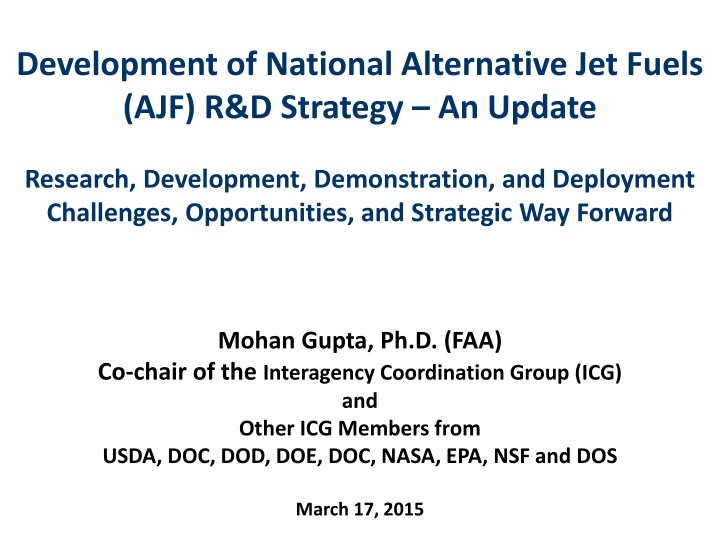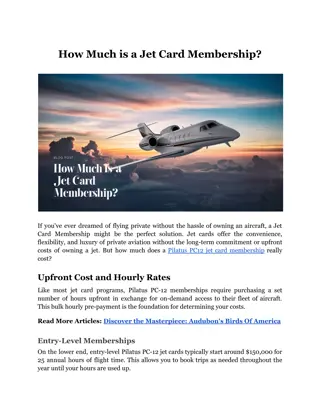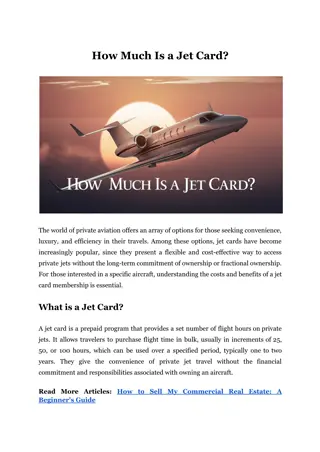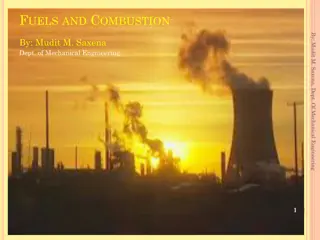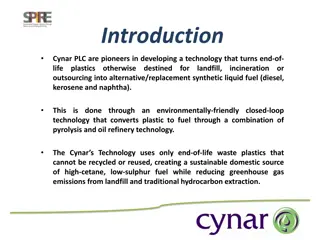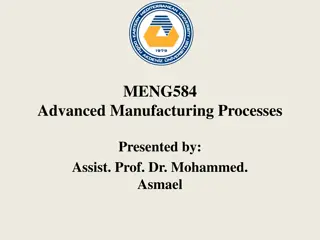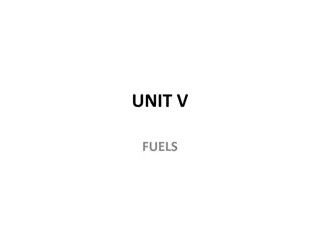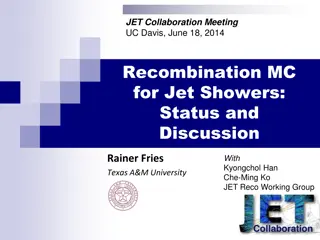National Alternative Jet Fuels R&D Strategy Update
This update focuses on the Research, Development, Demonstration, and Deployment challenges, opportunities, and strategic way forward for the development of national alternative jet fuels, highlighting coordination efforts and the AJF development path.
Download Presentation

Please find below an Image/Link to download the presentation.
The content on the website is provided AS IS for your information and personal use only. It may not be sold, licensed, or shared on other websites without obtaining consent from the author.If you encounter any issues during the download, it is possible that the publisher has removed the file from their server.
You are allowed to download the files provided on this website for personal or commercial use, subject to the condition that they are used lawfully. All files are the property of their respective owners.
The content on the website is provided AS IS for your information and personal use only. It may not be sold, licensed, or shared on other websites without obtaining consent from the author.
E N D
Presentation Transcript
Development of National Alternative Jet Fuels (AJF) R&D Strategy An Update Research, Development, Demonstration, and Deployment Challenges, Opportunities, and Strategic Way Forward Mohan Gupta, Ph.D. (FAA) Co-chair of the Interagency Coordination Group (ICG) and Other ICG Members from USDA, DOC, DOD, DOE, DOC, NASA, EPA, NSF and DOS March 17, 2015
Presentation Outline Background Snap-Shot of Current Status Next Steps Strategy Development Team USDA Harry Baumes, Bill Goldner DOC Dan Friend DOD Bret Strogen, Tim Edwards DOE Zia Haq EPA Aaron Levy FAA Mohan Gupta (Co-chair), Nathan Brown NASA Barb Esker (Co-chair) NSF Greg Rorrer DOS Dan Birns STPI Bhavya Lal, Mike Mineiro, Lucas Pratt and Emily Sylak-Glassman
NAJFS - Background AJF Drivers Energy Security Environmental Sustainability Social and Economic Benefits Addresses one of the goals of the National Aeronautics R&D Plan Support and help to grow the Bioeconomy National AERO R&D Plan focuses on 17 aeronautics goals in four areas Mobility, Security, Safety and Environment and Energy Energy Availability, Efficiency & Environmental Protection - Goal 1: Enable new aviation fuels derived from diverse & domestic resources to improve fuel supply security & price stability
Coordination Efforts Coordination needed across all links in the Development Path Alternative Jet Fuel Development Path Economic and environmental sustainability analysis across the entire Development Path Conversion Process Scale- up/Integration Feedstock Production & Development Fuel Testing/Evaluation Fuel Performance Feedstock Logistics Fuel End User/ Buyer Enable Production Environment Assessment Conversion R&D for feedstock options & cost R&D for conversion & improved conversion cost R&D for testing of fuels; transparent process for certification/qualification Production incentives; investment Fuel purchases Reduce cost & risk of feedstock production Guidance for airport use/handling Improve analysis of benefits & work towards converging standards for crediting Reduce cost to finance first-of-a-kind plants 4
AJF Development Path: Interagency Contributions Scale-up Fuel Conversion & Production Feedstock Development & Production Fuel Testing & Evaluation Fuel Performance Feedstock Logistics Fuel End User/ Buyer Enable Production Environment Assessment Conversion --- USDA --- DOC --- --- --- --- --- DoD --- --- DOE --- --- --- --- --- --- EPA FAA --- --- --- --- --- --- --- --- --- NASA --- --- --- --- --- NSF
Development of National Alternative Jet Fuels (AJF) R&D Strategy Intended Purpose Identify opportunities and strategically address challenges associated with Research, Development, Demonstration, and Deployment (RD3) along the development path of alternative jet fuels. An undertaking by the Aeronautical Science and Technology Subcommittee (ASTS) of the NSTC with input from stakeholders community. National AJF R&D Strategy A mechanism to ArticulateAspirational yet Achievable Objectives, Measurable Performance Metrics and Timeline to achieve the goal Mobilize the federal and non-federal stakeholders community towards achieving the common goal and objectives Understand industry needs and align federal strategic R&D efforts to address RD3 challenges along the alternative jet fuels supply-chain Integrate, align and coordinate interagency activities Promote increased collaboration Enhance technology transfer Goal Statement of the Strategy: Enable the development, production, and use of environmentally sustainable, cost-competitive and socially responsible alternative jet fuel with stable supply to significantly meet the needs of U.S. jet aviation.
Alternative Jet Fuels Development Path: System-Wide Challenges & Non-Linearities A complex enterprise in which the elements of the Development Path are inter-related. Strategy document utilizes the linear model of the Development Path. However, each of the elements of the Development Path are influenced by other elements. Examples: - Current and projected demand by End Users directly affects the desirability of investment in Feedstock Development & Production and Fuel Conversion & Scale-Up. - Perceptions about the complexity and amount of fuel required to succeed in the fuel certification process (part of Fuel Testing and Approval) directly affect the desirability and investment needed in Fuel Conversion Scale-Up. Strategy recognizes these interactions and provides rationale for cross- cutting efforts that integrate multiple elements of the Development Path.
National Alternative Jet Fuels R&D Strategy Scale-up Fuel Conversion & Production Feedstock Development & Production Fuel Testing & Approval Fuel Performance Feedstock Logistics Fuel End User/ Buyer Enable Production Environment Assessment Conversion Feedstock Production & Logistics Conversion & Scale-up Fuel Testing & Evaluation Organization of Strategy Goals and Objectives Three thematic topic sections - Feedstock Development, Production and Logistics - Fuel Conversion and Scale-up - Fuel Testing & Evaluation (including certification and qualification) Section on Integrated Challenges considerations that span entire development path and the interfaces Categorized objectives along three time horizons: Near- (<5 years), Mid- (5-10 years) and Far- (>10 years) term - similar to National Aeronautics R&D Plan Acknowledge non-R&D context of policy (e.g., RFS), economic factors/challenges, & international considerations
Strategy Development: Timeline and Process for Information Collection June, 2014: First draft released following interagency review Nov 3, 2014: Meeting with ASTS on next steps April 4, 2013: Interagency kickoff meeting Fall, 2013: Stakeholders online survey Summer, 2010: Idea seeded 2010 Jan 7, 2014: Workshop with stakeholders Ist Qtr 2013: ASTS Go Ahead Aug/Sep, 2014: Briefings to IAWG and BRDI 2nd Qtr 2013: OSTP meetings with Industry Jan 19, 2015: Received Workshop participants comments on the draft Strategy Current Status Addressing comments received from the stakeholders Next Step Conduct another round of D&A review Secure review and approval from ASTS and CoT/NSTC for Strategy release
Summary US Agencies recognize the complex, inter-related nature of the alternative jet fuel enterprise. The complexity of the enterprise warrants close, inter-agency communication and coordination. NASA DOC DOE Federal Agencies have self-organized to not only more closely coordinate but also codifying their coordination and common goals in an actionable National strategy. FAA Academia DoD International NSF EPA USDA DOS Industry
